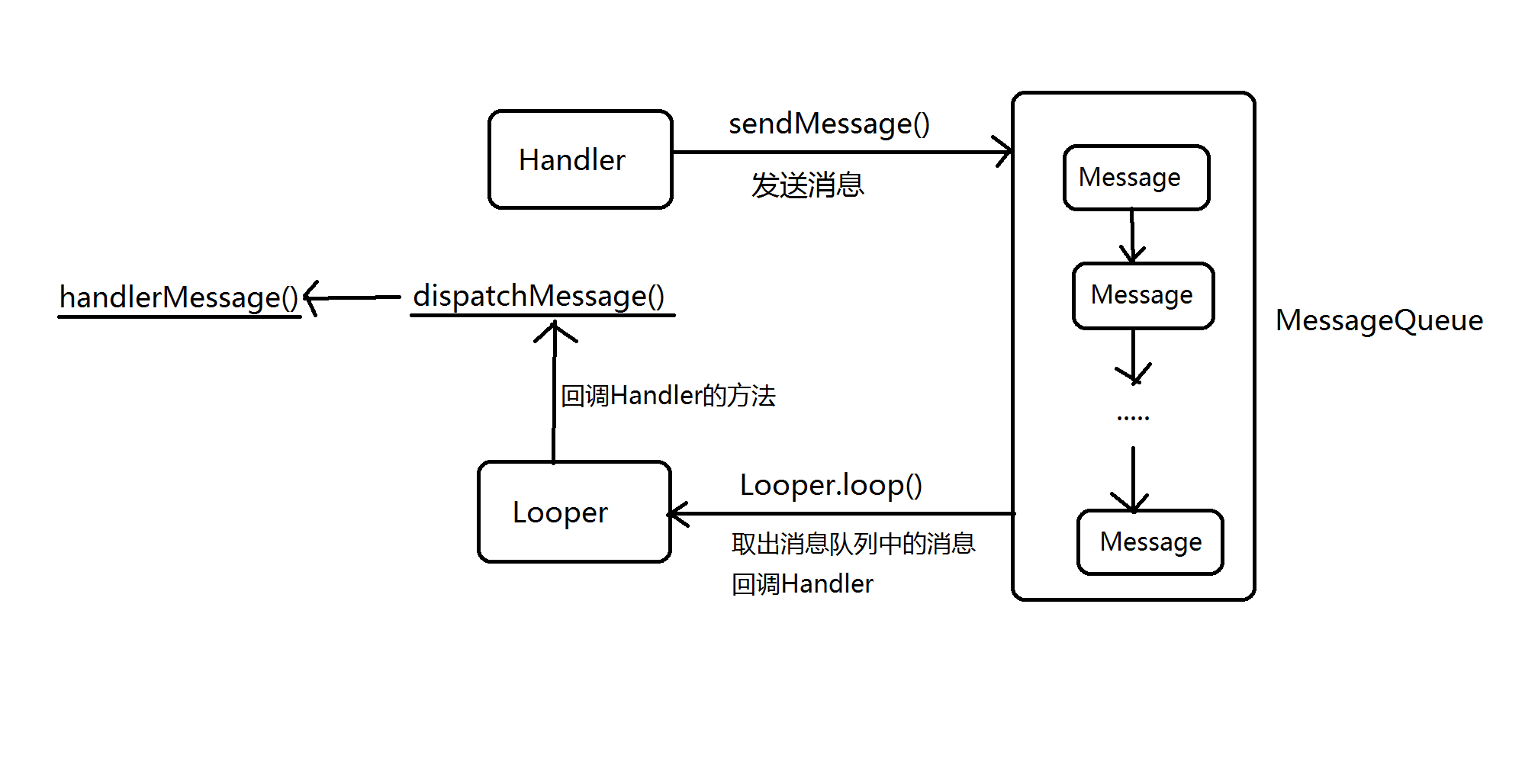【Android】消息通信 Handler 源码解析
: May 19, 2016
: Android
: onlylemi/notes/tree/master/Android
在 Android 中我们通过 Handler 进行主线程与子线程之间的消息通信,对 UI 视图的更新等。
相关类

Handler—— 发送消息 sendMessage 与处理消息 handleMessageLooper—— 负责消息的分发MessageQueue—— 消息队列,handler 发送的消息都会存到这个消息队列中,通过 Looper.loop() 去分发消息Message—— 消息对象
##
使用
在子线程中,通过 Handler 更新 UI 有四种方式。以更新 TextView 的值为参考,以下部分知识主要代码,如果我们直接在子线程中直接更新 UI 线程,就会下面的异常
异常
- 异常1
Process: com.onlylemi.test1_handler, PID: 1682
android.view.ViewRootImpl$CalledFromWrongThreadException: Only the original thread that created a view hierarchy can touch its views.
- 异常2
Process: com.onlylemi.test1_handler, PID: 1982
java.lang.RuntimeException: Can't create handler inside thread that has not called Looper.prepare()
子线程更新 UI 方式
项目源代码请看这里:https://github.com/onlylemi/AndroidTest/tree/master/Test1_Handler
- 第1种:handler.post()
public void run() {
try {
Thread.sleep(2000);
handler.post(new Runnable() {
@Override
public void run() {
textView.setText("Text View1");
}
});
} catch (InterruptedException e) {
e.printStackTrace();
}
}
- 第2种:handler.sendMessage()
private Handler handler = new Handler(){
@Override
public void handleMessage(Message msg) {
textView.setText("Text View2");
}
};
public void run() {
try {
Thread.sleep(2000);
// 子线程中发送一个 handler 消息,通过 handler 去处理这个消息
handler.sendEmptyMessage(1);
} catch (InterruptedException e) {
e.printStackTrace();
}
}
- 第3种:runOnUiThread()
public void run() {
try {
Thread.sleep(2000);
runOnUiThread(new Runnable() {
@Override
public void run() {
textView.setText("Text View1");
}
});
} catch (InterruptedException e) {
e.printStackTrace();
}
}
- 第4种:textView.post()
public void run() {
try {
Thread.sleep(2000);
textView.post(new Runnable() {
@Override
public void run() {
textView.setText("Text View1");
}
});
} catch (InterruptedException e) {
e.printStackTrace();
}
}
子线程中生成一个 Handler
class MyThread extends Thread {
public Handler handler1;
public Looper looper;
@Override
public void run() {
Looper.prepare();
looper = Looper.myLooper();
handler1 = new Handler() {
@Override
public void handleMessage(Message msg) {
Log.i(TAG + " thread:", Thread.currentThread().getName());
handler.sendEmptyMessageDelayed(1, 1000);
}
};
Looper.loop();
looper.quit();
}
}
源码解析
new Handler()
当我们在生成一个 Handler 对象前,必须调用 Looper.prepare() 方法,去检查我们当前的线程中是否已经存在一个 Looper 对象,不存在时就去去创建。
// 当我们在一个 Handler 对象的时候,总会执行到这个构造函数
public Handler(Callback callback, boolean async) {
if (FIND_POTENTIAL_LEAKS) {
final Class<? extends Handler> klass = getClass();
if ((klass.isAnonymousClass() || klass.isMemberClass() || klass.isLocalClass()) &&
(klass.getModifiers() & Modifier.STATIC) == 0) {
Log.w(TAG, "The following Handler class should be static or leaks might occur: " +
klass.getCanonicalName());
}
}
// 在这里会 Looper 去获取当前线程中的 looper 对象
mLooper = Looper.myLooper();
// 当这个对象为 null 时,就会报【异常2】,所以我们要在 生成 handler 对象之前去生成一个 Looper
if (mLooper == null) {
throw new RuntimeException(
"Can't create handler inside thread that has not called Looper.prepare()");
}
mQueue = mLooper.mQueue;
mCallback = callback;
mAsynchronous = async;
}
// 调用 prepare() 方法,生成一个 Looper 实例
public static void prepare() {
prepare(true);
}
private static void prepare(boolean quitAllowed) {
// 获取当前的线程的 looper 对象,不为 null 时,报异常提示不用重复 prepare()
if (sThreadLocal.get() != null) {
throw new RuntimeException("Only one Looper may be created per thread");
}
// 若为 null 时,会重新生成一个 Looper 对象,所以 prepare() 就是为了生成一个 looper
sThreadLocal.set(new Looper(quitAllowed));
}
但是会发现在 UI 线程中我们并没有去生成一个 looper,但是也没有报异常,这是因为,Android 在启动的过程中,就会默认为 UI 线程生成一个 Looper 对象,在 ActivityThread 中会发现在 main() 中调用 Looper.prepareMainLooper() 方法
// 应用启动时会调用 ActivityThread 的 main() 入口
public static void main(String[] args) {
// 省略之前代码...
// 调用此方法,生成一个 UI 线程的一个 Looper 对象
Looper.prepareMainLooper();
ActivityThread thread = new ActivityThread();
thread.attach(false);
if (sMainThreadHandler == null) {
sMainThreadHandler = thread.getHandler();
}
if (false) {
Looper.myLooper().setMessageLogging(new
LogPrinter(Log.DEBUG, "ActivityThread"));
}
// End of event ActivityThreadMain.
Trace.traceEnd(Trace.TRACE_TAG_ACTIVITY_MANAGER);
// 分发消息
Looper.loop();
throw new RuntimeException("Main thread loop unexpectedly exited");
}
// 再看 Looper.prepareMainLooper() 方法的实现,也是调用了 prepare() 所以就明白,在 UI 线程中,我们不需要再 调用 Looper.prepare() 去生成 Looper 实例
public static void prepareMainLooper() {
prepare(false);
synchronized (Looper.class) {
if (sMainLooper != null) {
throw new IllegalStateException("The main Looper has already been prepared.");
}
sMainLooper = myLooper();
}
}
从上面我们会发现,当我们自己调用
prepare()生成一个Looper对象时,内部实现调用的是prepare(true),而在ActivityThread中调用prepareMainLooper()方法时,调用的是prepare(false)。其实这里的参数的意思代表我们当前线程的Looper是否需要quit,默认认为 UI 线程的 Looper 不可以,所以为false;子线程中的Looper可以退出,所以为true。
当我们在子线程中更新 UI 的时候,Handler内部发生了什么,我们在主线程中是这样使用,通过 sendMessage() 发送消息,然后在 handlerMessage() 中处理消息
private Handler handler = new Handler(){
@Override
public void handleMessage(Message msg) {
textView.setText("Text View2");
}
};
public void run() {
try {
Thread.sleep(2000);
// 子线程中发送一个 handler 消息,通过 handler 去处理这个消息,通过 handlerMessage() 方法
handler.sendEmptyMessage(1);
} catch (InterruptedException e) {
e.printStackTrace();
}
}
sendMessage()
在这里我们采用,handler.sendEmptyMessage(1) 去发送一个空消息
// 发送一个空的消息
public final boolean sendEmptyMessage(int what) {
return sendEmptyMessageDelayed(what, 0);
}
public final boolean sendEmptyMessageDelayed(int what, long delayMillis) {
// 内部也会把这个消息 封装成一个消息对象
Message msg = Message.obtain();
msg.what = what;
return sendMessageDelayed(msg, delayMillis);
}
// 而对于 sendMessage 直接发送传递的消息就可以
public final boolean sendMessage(Message msg){
return sendMessageDelayed(msg, 0);
}
// 消息发送的延迟时间 delayMillis
public final boolean sendMessageDelayed(Message msg, long delayMillis) {
if (delayMillis < 0) {
delayMillis = 0;
}
return sendMessageAtTime(msg, SystemClock.uptimeMillis() + delayMillis);
}
public boolean sendMessageAtTime(Message msg, long uptimeMillis) {
// 对于 handler 发送的消息,都会存放在一个 MessageQueue 消息队列中
MessageQueue queue = mQueue;
if (queue == null) {
RuntimeException e = new RuntimeException(
this + " sendMessageAtTime() called with no mQueue");
Log.w("Looper", e.getMessage(), e);
return false;
}
return enqueueMessage(queue, msg, uptimeMillis);
}
private boolean enqueueMessage(MessageQueue queue, Message msg, long uptimeMillis) {
// 每个消息都会有一个 target,相当于这个消息将来会发给谁,默认为 this,也就是 每个 handler 自己发送的消息自己将来去处理
msg.target = this;
if (mAsynchronous) {
msg.setAsynchronous(true);
}
return queue.enqueueMessage(msg, uptimeMillis);
}
// MessageQueue 的 enqueueMessage 方法在 ide 下不能查看,我们通过 Source Insight 可以看到,
// 将我们发送的每一个消息通过 Message 的 next 连接成链表,维护在消息队列中
boolean enqueueMessage(Message msg, long when) {
// 这儿就可以看出,每个 msg 必须有它的 target
if (msg.target == null) {
throw new IllegalArgumentException("Message must have a target.");
}
if (msg.isInUse()) {
throw new IllegalStateException(msg + " This message is already in use.");
}
synchronized (this) {
if (mQuitting) {
IllegalStateException e = new IllegalStateException(
msg.target + " sending message to a Handler on a dead thread");
Log.w(TAG, e.getMessage(), e);
msg.recycle();
return false;
}
msg.markInUse();
msg.when = when;
Message p = mMessages;
boolean needWake;
if (p == null || when == 0 || when < p.when) {
// New head, wake up the event queue if blocked.
msg.next = p;
mMessages = msg;
needWake = mBlocked;
} else {
// Inserted within the middle of the queue. Usually we don't have to wake
// up the event queue unless there is a barrier at the head of the queue
// and the message is the earliest asynchronous message in the queue.
needWake = mBlocked && p.target == null && msg.isAsynchronous();
Message prev;
for (;;) {
prev = p;
p = p.next;
if (p == null || when < p.when) {
break;
}
if (needWake && p.isAsynchronous()) {
needWake = false;
}
}
msg.next = p; // invariant: p == prev.next
prev.next = msg;
}
// We can assume mPtr != 0 because mQuitting is false.
if (needWake) {
nativeWake(mPtr);
}
}
return true;
}
这样我们发送的消息,全都存到了 MessageQueue 中,我们先了解下 Message
Message
handler 在发送消息的时候,sendMessage() 方法会传递一个 Message 对象
what—— 消息的标识arg1、arg1—— 提供的两个传递简单 int 型参数obj—— 传递的一个 Object 对象date—— Bundle 对象。把需要传递的数据封装到 Bundle 中进行传递target—— Handler对象。消息最终传递的目标 Handler,在 Looper.loop() 使用该 target 来回调 handler 的 dispatchMessage() 方法callback—— Runnable 对象。当我们在子线程中采用 post 方式更新 UI 时,需要用它来回调
// 生成一个 msg 对象时,建议使用 obtain() 方法,也就是单例模式
// 也可以使用 new Message()
Message msg = Message.obtain();
msg.arg1 = 1;
// 发送消息
handler.sendMessage(msg);
Looper.loop()
我们 handler 发送的所有消息都储存在 MessageQueue 消息队列中,再通过 Looper.loop() 去分发这些消息
public static void loop() {
// 首先获取当前线程的 looper 对象
final Looper me = myLooper();
if (me == null) {
throw new RuntimeException("No Looper; Looper.prepare() wasn't called on this thread.");
}
// 通过,looper 对象获取该线程的消息队列
final MessageQueue queue = me.mQueue;
// Make sure the identity of this thread is that of the local process,
// and keep track of what that identity token actually is.
Binder.clearCallingIdentity();
final long ident = Binder.clearCallingIdentity();
// 消息处理的时候是个死循环,知道所有消息都处理完毕
for (;;) {
Message msg = queue.next(); // might block
if (msg == null) {
// 没有消息时,直接退出
return;
}
// This must be in a local variable, in case a UI event sets the logger
Printer logging = me.mLogging;
if (logging != null) {
logging.println(">>>>> Dispatching to " + msg.target + " " +
msg.callback + ": " + msg.what);
}
// 通过 msg 的 target 去回调该消息 handler 的 dispatchMessage() 方法
msg.target.dispatchMessage(msg);
if (logging != null) {
logging.println("<<<<< Finished to " + msg.target + " " + msg.callback);
}
// Make sure that during the course of dispatching the
// identity of the thread wasn't corrupted.
final long newIdent = Binder.clearCallingIdentity();
if (ident != newIdent) {
Log.wtf(TAG, "Thread identity changed from 0x"
+ Long.toHexString(ident) + " to 0x"
+ Long.toHexString(newIdent) + " while dispatching to "
+ msg.target.getClass().getName() + " "
+ msg.callback + " what=" + msg.what);
}
msg.recycleUnchecked();
}
}
// handler 的 dispatchMessage 方法
public void dispatchMessage(Message msg) {
// 首先判断 msg 的 callback 是否为 null,为空时直接调用 handleCallback(msg) 方法
if (msg.callback != null) {
handleCallback(msg);
} else {
if (mCallback != null) {
if (mCallback.handleMessage(msg)) {
return;
}
}
// 会回调 handleMessage() 方法,我们在 new Handler() 的时候必须重写这个方法
handleMessage(msg);
}
}
// 在 handleCallback 方法中直接调用 run() 方法
private static void handleCallback(Message message) {
message.callback.run();
}
在开头更新 UI 的其他几种 post 方式,查看源码你会发现,最终都会调用到 handler.post() 这个方法,
// post 方法也会调用 sendMessageDelayed() 去发送消息,
// 不过先需要 getPostMessage(r) 去封装这个消息对象
public final boolean post(Runnable r) {
return sendMessageDelayed(getPostMessage(r), 0);
}
private static Message getPostMessage(Runnable r) {
Message m = Message.obtain();
// 会把你传递的 runnable 对象,赋给 msg 的 callback
// 这样在 dispatchMessage 中判断的时候就会回调 handleCallback(msg) 方法
m.callback = r;
return m;
}
从以上我们会发现
callback直接去调用run()方法,所以在这里post(new Runnable())其实就是一个普通的回调函数,千万不要当成是新开一个线程
HandlerThread
Activity 中我们 new handler() 对象的消息处理都是在主线程中,当我们需要让 handler 的消息处理在子线程中时,我们需要在生成 handler 对象时传递子线程中的一个 looper 对象,如果我们自己在子线程中生成一个 looper,然后给 hander 使用时,因为线程的不同步,我们并不能保证在 new handler 是,looper 已经在子线程中生成了,我们就需要用到 HandlerThread,他帮我们解决这个问题
不使用 HandlerThread
private MyThread thread;
private Handler handler;
@Override
protected void onCreate(Bundle savedInstanceState) {
super.onCreate(savedInstanceState);
TextView textView = new TextView(this);
textView.setText("SecondActivity");
setContentView(textView);
thread = new MyThread();
thread.start();
// looper 你确定真的已经生成了吗?(线程不同问题,可能会报空指针异常)
handler = new Handler(thread.looper) {
@Override
public void handleMessage(Message msg) {
Log.i(TAG + " thread:", Thread.currentThread().getName());
}
};
handler.sendEmptyMessage(1);
}
class MyThread extends Thread {
public Looper looper;
@Override
public void run() {
// 生成 looper 对象
Looper.prepare();
// 获取 looper 对象
looper = Looper.myLooper();
// 分发消息
Looper.loop();
}
}
可能就像上面一样,你会这样去写,这样的结果就是可能会报空指针异常,看这里代码
public Handler(Looper looper) {
this(looper, null, false);
}
public Handler(Looper looper, Callback callback, boolean async) {
mLooper = looper;
// looper 如果为 null 就会报空指针啊
mQueue = looper.mQueue;
mCallback = callback;
mAsynchronous = async;
}
使用 HandlerThread
private HandlerThread thread;
protected void onCreate(Bundle savedInstanceState) {
super.onCreate(savedInstanceState);
TextView textView = new TextView(this);
textView.setText("ThirdActivity");
setContentView(textView);
thread = new HandlerThread("Handler Thread");
thread.start();
// handler = new Handler() {
handler = new Handler(thread.getLooper()) {
@Override
public void handleMessage(Message msg) {
Log.i(TAG, "thread: " + Thread.currentThread().getName());
// 空参数时,输出:main (UI 主线程)
// 有参数时,输出:Handler Thread (子线程)
}
};
handler.sendEmptyMessageDelayed(1, 1000);
}
如果采用 HandlerThread 去获取 looper 一定会获取到,因为加了同步锁
public Looper getLooper() {
if (!isAlive()) {
return null;
}
synchronized (this) {
while (isAlive() && mLooper == null) {
try {
// 如果 looper 为空,进入 wait 状态,直到被调用 notify()或notifyAll()
wait();
} catch (InterruptedException e) {
}
}
}
return mLooper;
}
@Override
public void run() {
mTid = Process.myTid();
Looper.prepare();
synchronized (this) {
mLooper = Looper.myLooper();
// 当获取到 looper 对象时,调用 notifyAll,保证了 getLooper() 获取到的 looper 一定不为 null
notifyAll();
}
Process.setThreadPriority(mPriority);
onLooperPrepared();
Looper.loop();
mTid = -1;
}
如果我的文章对您有所帮助,就请我喝杯咖啡吧^^



Messages